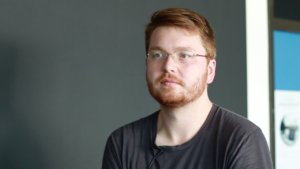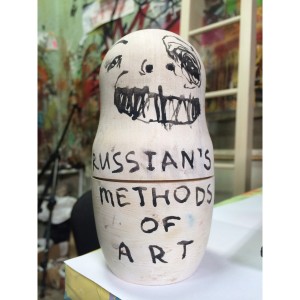I think the following elements are essential for the process: the location, the room, the person acting on site, political, social and other factors. It’s different in every project but the basic constellation seems to be similar. It seems to me impossible to work in a specific location and hide these contexts. This means there are clear steps. They are research, travel research, material research and preparative considerations, which are then gathered together roughly, not really deeply structured, but rather on the surface. Then they will be discussed with the process partners on site. Those may be curators, but those may also be a group of students in Lüneburg as in the project Urban Context with the Gauleitungsbunker, where the underground artwork was banned by the mayoral and therefore was shown on the ground level. Where the philosopher Paul Virilio and the art historian Manfred Schneckenburger, who had twice organised the exhibition documenta, were involved. This means there are always a lot of people en route. I do not even know how many co-producers have been on the move over the years, shoulder to shoulder with me in these projects. That is why the process itself is partly incredibly complex and difficult. Because I live for a few days, sometimes weeks, next to a hole, and looking inside I think: this and that happened here and now something new must be created. What is my part supposed to be here? Of course at first I feel small, obscure and minor because of that. This is right anyway because it is also an important thought. And then to fill the whole thing with an idea and to see if the idea is viable, if it can form partnerships, if maybe others are interested to cooperate. And if they are, how could it be, this collaboration? Yes, that is also part of this process. Or I do say something deliberately. So in the synagogue, it was important to me that the neighbors would be the first to hear of the project instead of reading it in the newspaper: “There is an artist who does something in there.” In São Paulo I have first asked the Cafeteria, the coffee lady Donna Gloria and then, after her, the president of the Biennale. And I said, I have already a participant and he was naturally very interested in this prominent lady. When I told him it was one of his employees he was totally confused, but then also understood what sort of a project it really is. The project shall show that this society, despite the need for solidarity, reveals a very clear separation of economics and micro-economics, represented by the coffee lady who did not even had a name for him, but rather a function. And in exactly these moments I realize: this is the process that is entered by the work. So to speak: the nucleus may already be set for the intensity of the work and its impact by the gesture of response, by the gesture of invitation and by the structure in which way that happens. This goes far beyond of what is visible in an exhibition or in a documentary. And this is why every project is a process. And individual processes result from processes. There is no clear separation. I cannot say on how many projects I am working at the same time. I could mention a number that may appear rather daunting or scary. So if I go for a run in the morning, many of these projects cross my mind and then I think about individual steps that we then discuss here in the studio. Something has to be sent there, we still have to answer that, there is no question yet, there is still a need of material research and so it grows and grows. And this is how a project enters the stage of realization or transfers into a more condensed form. But it is not really finished, even if they have this special form of existence in these hanging files, somehow. This only exists for the reason, for me having a direct access when I need it. This is not the actual form of existence. The form of existence is the idea, and finally there are memorials that keep the idea awake, sometimes it is a photograph and sometimes it is a video or a statement or a publication that reminds me of it. And sometimes it is an entire room, but nothing helps, no matter how large the cost of materials seems to be, the idea is in the important. This means I have a lot more to deal with the fact, that I disappear and that the work disappears, because so many things are not permanent, but rather procedural. Maybe two, four or six weeks and then they are gone. Very few things remain permanently, just like the project in Christchurch. And the others leave a trail. This means for me as an artist that this trail and the memory in the collective memory of a society or a generation, have a quality in itself. Book publications are the things that can tell you about a special feature of the project. And luckily I have appreciated this very, very early, although I do not know why. I actually do have a complete documentation of my artistic works since 1980. There is hardly a project that is not documented.
Also ich glaube die Elemente, die für den Prozess maßgeblich sind, also der Ort, der Raum, die handelnde Person vor Ort, politische, soziale und andere Faktoren, das ist ja in jedem Projekt anders, aber die Grundkonstellation scheint ähnlich. Es scheint also für mich mittlerweile unmöglich zu sein, an einem Ort zu arbeiten und diese Kontexte auszublenden. Das heißt es gibt klare Schritte. Das heißt Recherche: Recherche-Reise, Recherche-Material und vorbereitende Überlegungen, die dann grob zusammengerafft werden, nicht wirklich tief strukturiert, sondern eher an der Oberfläche. Sie werden dann mit den Prozesspartnern vor Ort besprochen. Das können Kuratoren sein, dass kann aber auch eine Studentengruppe in Lüneburg sein, bei dem „Urban Context“ Projekt mit dem Gauleitungsbunker, wo ja die unterirdische Arbeit vom Bürgermeister verboten wurde und deswegen dann die Arbeit an der Oberfläche gezeigt wurde. Wo wir dann einen Philosophen wie den Paul Virilio und einen Kunsthistoriker und zweifachen Dokumentamacher wie den Manfred Schneckenburger mit einbezogen haben. Also das heißt es sind schon immer auch eine Menge Leute mit unterwegs. Ich weiß gar nicht wie viele Mitproduzenten sich über die Jahre, sozusagen Schulter an Schulter mit mir, an diesen Projekten bewegt haben. Deswegen ist der Prozess selber zum Teil unglaublich komplex und schwierig, weil ich lebe dann für ein paar Tage, manchmal Wochen an so einem Loch und guck` da rein und denke: Hier ist das und das passiert und hier soll etwas Neues entstehen. Was soll da meine Rolle sein? Da komme ich mir natürlich auch erst mal eingerückt und klein und unbedeutend vor. Ist ja auch richtig, weil das ist ja auch ein wichtiger Gedanke. Und dann das Ganze mit einer Idee sozusagen anzufüllen und zu gucken, ob die Idee tragfähig ist, ob sie Partnerschaften bilden kann, ob vielleicht andere auch Lust oder Interesse haben mitzuarbeiten. Und wenn ja, wie sieht denn diese Mitarbeit aus? Ja, das ist schon auch Teil dieses Prozesses. Oder ich sage etwas ganz bewusst. Also bei der Synagoge war es mir wichtig, dass die Nachbarn als erstes von dem Projekt erfahren und nicht aus der Zeitung lesen: Da kommt ein Künstler und macht da was. In Sao Paulo habe ich zuerst die Copeteria, die Kaffeefrau Donna Gloria gefragt und dann den Präsidenten der Biennale und habe gesagt ich habe schon eine Teilnehmerin und er war natürlich ganz interessiert an dieser prominenten Dame. Als ich ihm sagte, es sei eine Mitarbeiterin, war er total irritiert, hat dann aber auch verstanden was das Projekt ist. Das Projekt soll eben auch zeigen, dass sich in dieser Gesellschaft trotz der Notwendigkeit von Solidarität eben auch eine ganz klare Trennung von Ökonomien und Mikroökonomien aufzeigt und dass die Kaffeefrau für ihn noch nicht mal einen Namen hatte, sondern eher eine Funktion. Und genau da, an diesen Momenten, da merke ich: Das ist der Prozess, den diese Arbeit eingeht. Nämlich zu sagen: Es kann schon durch die Geste des Ansprechens, durch die Geste der Einladung und durch die Struktur wie das passiert, kann schon der Nukleus gelegt werden für die Intensität der Arbeit und ihre Auswirkung. Das geht weit über das hinaus, was dann in einer Ausstellung oder in einer Dokumentation sichtbar wird. Und deswegen ist jedes Projekt ein Prozess. Und aus Prozessen entstehen einzelne Projekte. Es gibt keine klare Trennung. Ich kann auch nicht sagen an wie vielen Projekten ich gleichzeitig arbeite. Ich könnte eine Zahl sagen, die wirkt dann vielleicht eher abschreckend oder erschreckend. Also wenn ich morgens Laufe, gehen mir viele, viele von diesen Projekten durch den Kopf und ich überlege dann einzelne Schritte, die wir dann eben hier im Atelier besprechen. Da muss noch etwas hingeschickt werden, da muss noch eine Antwort hin, da muss noch eine Frage hin, da muss noch Material recherchiert werden und so wächst und wächst das. Und so kommt dann ein Projekt in die Phase, dass es in die Realisierung gehen kann oder in eine verdichtetere Form. Aber so richtig abgeschlossen, auch wenn die dann da in diesen Hängeregister irgendwie so eine besondere Existenzform oder so haben, ist es eigentlich nicht. Das ist ja dafür da, dass ich einen direkten Zugriff drauf habe, wenn ich es brauche. Das ist nicht die eigentliche Existenzform. Die Existenzform ist die Idee und letztlich gibt es Erinnerungszeichen, die die Idee wach halten und manchmal ist das eine Fotografie, die daran erinnert und manchmal ist es ein Video oder ein Statement oder auch eine Publikation. Und manchmal ist es ein ganzer Raum, aber es hilft alles nichts, egal wie groß der Materialaufwand scheint, die Idee steht im Vordergrund. Das heißt ich muss viel stärker damit umgehen, dass ich verschwinde und dass das Werk verschwindet, weil ja viele Dinge nicht dauerhaft sind, sondern eher prozessual. Vielleicht zwei, vier oder sechs Wochen und dann sind sie weg. Weniges, wie beispielsweise das Projekt in Christchurch, bleibt dauerhaft. Und das Andere zieht eine Spur. Das heißt für mich als Künstler ist dieses Spurziehen und mit der Erinnerung im kollektiven Gedächtnis einer Gesellschaft bzw. einer Generation zu tun zu haben, das ist für mich eine Qualität an sich. Bücherpublikationen sind die Sachen, die über die Besonderheit des Projektes erzählen können. Und da habe ich vielleicht, ich weiß nicht warum, glücklicherweise schon sehr, sehr früh drauf Wert gelegt. Und habe seit 1980 eigentlich eine lückenlose Dokumentation der künstlerischen Arbeit. Es gibt kaum ein Projekt, was nicht dokumentiert ist.

















